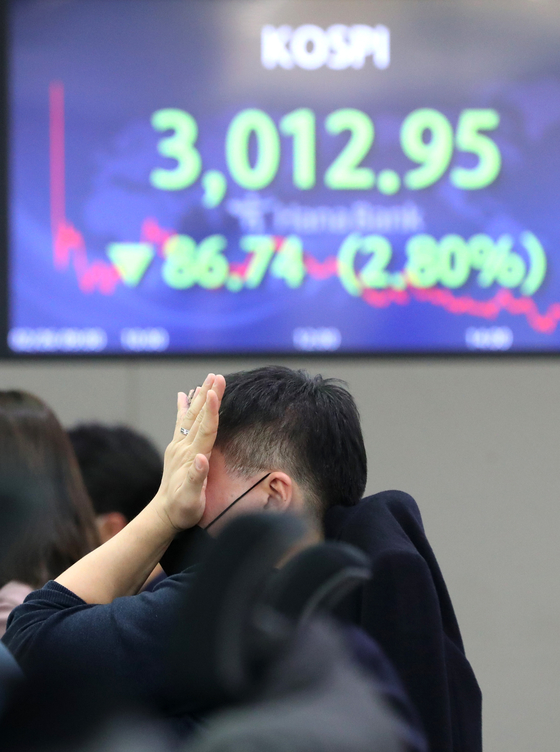
On the afternoon of the 26th, the KOSPI index declined 86.74 points (2.8%) from the previous day to 3,012.95 on the display board of the dealing room at Hana Bank’s Myeongdong branch in Jung-gu, Seoul. News 1
Fear of a surge in US Treasury yields hit Asian financial markets again. The KOSPI plunged close to 3% in one day and retreated to the 3010 line.
It started in America. On the 25th (local time), the 10-year U.S. Treasury bond rate soared to 1.6% per annum during the week, and the New York Stock Market plunged at once. As the market interest rate rises, the debt burden on companies increases and the attractiveness of investing in stocks declines. In the aftermath, the Nasdaq Index, which is mainly for technology stocks, fell 3.52%, and the Dow Jones (-1.75%) and Standard & Poor’s (S&P) 500 (-2.45%) were also pushed back. The decline of the NASDAQ index was the largest since the end of October last year.
The rise in interest rates is the growing concern that inflation (inflation may rise). Jerome Powell, chairman of the Federal Reserve (Fed) of the United States, has also ended his campaign to appease the market in one day. Park Hee-chan, a researcher at Mirae Asset Daewoo, said, “Even though Powell’s inflation concerns ease, market participants do not fully trust the remarks.”
Fed Chairman Powell dismissed inflation concerns at a parliamentary hearing on the 24th, saying, “It will take three years to reach the Fed’s inflation target,” but the market is not feeling anxious about early taper (reduced asset purchases).
Despite the net purchase of 3.8 trillion ants, foreigners and institutions cannot strive
The aftermath of the surge in government bond yields spread like a domino to Asian stock markets on the 26th. Japan’s Nikkei index fell 3.99%, giving it a 30,000 line. This is the biggest drop in 4 years and 8 months since June 24, 2016. Stock markets in Hong Kong, China and Taiwan also fell by 2-3%.
Korea’s KOSPI closed at 3012.95, down 86.74 points (2.8%) from the previous day. Most of the previous day’s increase (104.71 points) was returned. It was pushed to 2988.28 (-3.59%) during the day, but barely kept the 3000 line by reducing the fall in the curtain.
On this day, an individual investor started to defend the index by net buying about 3.800 trillion won, but it was not enough to reverse the sharp decline. This is because foreigners and institutions sold stocks worth 2.8 trillion won and 1 trillion won, respectively. The KOSDAQ index was also pushed to the 910 line. It ended at 913.94, down 2.38% from the previous day.
The top stocks in the KOSPI market capitalization were generally’blue bull’ (meaning a decline). Large-cap stocks in the 40th place, including Samsung Electronics (-3.28%) and SK Hynix (-4.71%), plunged. There were also events with wings in the fall. Kakao (0.72%) showed an expectation for a par value split, and Kia Motors (3.12%) showed a positive effect on the possibility of cooperation in other electric vehicle sectors excluding the autonomous driving sector with Apple in the United States, respectively, driving in reverse.
The impact of the surge in US Treasury yields shook the foreign exchange market. In the Seoul foreign exchange market, the value of the won per dollar recorded 1123.5 won, down 15.7 won from the previous day (the exchange rate increased). The decline is the largest since March 23 (20 won) last year. Seung-ji Jeon, a researcher at Samsung Futures, said, “As the stock price plunged due to the rise in US Treasury yields, risk aversion boosted the exchange rate.”
Reporter Hwang Eui-young [email protected]
![]()
